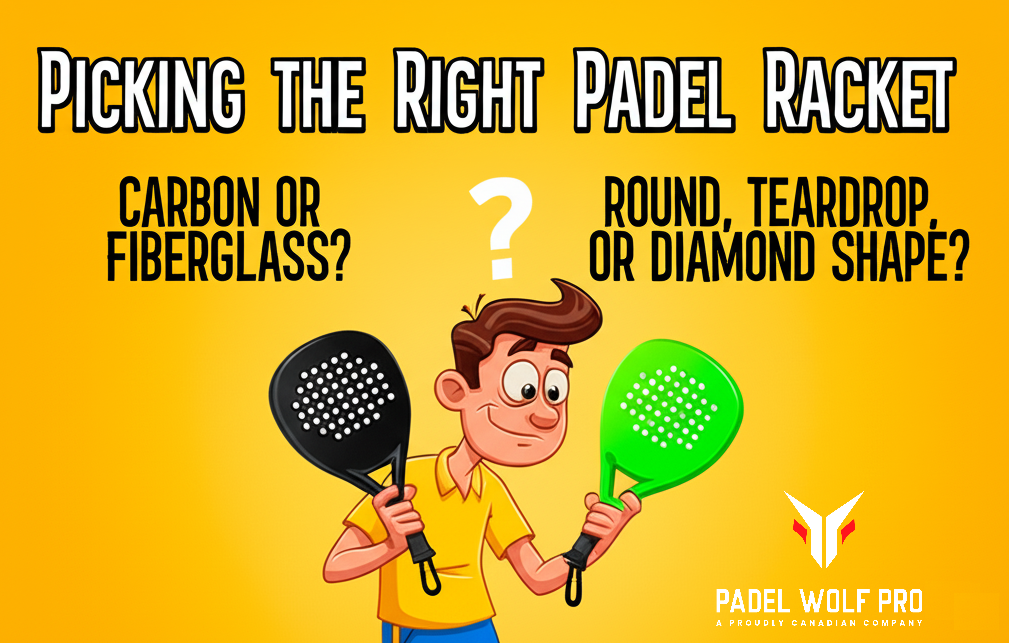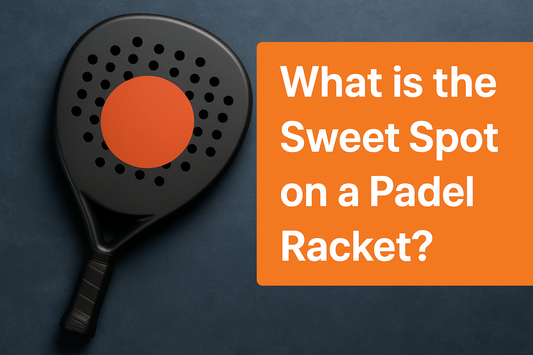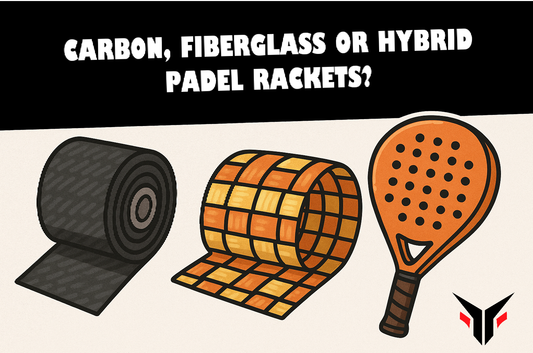
The Ultimate Guide to Buying Padel Rackets: What You Need to Know
Share
Table of Contents
- 1. Understand the Different Padel Racket Shapes
- 2. Consider the Weight of the Racket
- 3. Core Materials: EVA vs. FOAM
- 4. Surface Material and Finish
- 5. Grip and Comfort
- 6. Skill Level and Playing Style
- 7. Budget Considerations
- 8. Try Before You Buy
- Final Thoughts
- Frequently Asked Questions (FAQs)
- About the Author
1. Understand the Different Padel Racket Shapes
Round Padel Rackets
These are ideal for beginners or players who prioritize control over power. The sweet spot is located in the center, making it easier to hit clean shots even if you're still developing consistency. Round rackets generally have a lower balance point, meaning the weight is distributed more toward the handle. This makes them more maneuverable and easier on the arm.
Teardrop Padel Rackets
Teardrop-shaped rackets are a popular choice among intermediate players. They offer a good compromise between power and control, with a sweet spot located slightly higher than in round rackets. These rackets suit players who are developing an attacking game but still want reliable control on defensive shots.
Diamond Padel Rackets
Diamond-shaped rackets are designed for advanced players who prioritize power, especially in smashes and volleys. The sweet spot is higher and the balance is toward the top of the racket, making it less forgiving but extremely powerful. They require more precision and technique, and are best suited for offensive players with good physical conditioning.
2. Consider the Weight of the Racket
Weight plays a crucial role in how a racket performs. Lighter rackets (340–360g) offer superior maneuverability, making them easier to swing and control, especially for volleys and quick reactions. Heavier rackets (375g+) provide more inertia and power but can be taxing on the wrist and shoulder. Medium-weight rackets (360–375g) are versatile and suitable for players seeking a balance between control and power. Remember to also consider the balance point—rackets can be head-heavy, head-light, or evenly balanced.
3. Core Materials: EVA vs. FOAM
EVA (Ethylene Vinyl Acetate)
EVA is a denser, firmer core material. It lasts longer and provides greater control, making it the preferred choice for many intermediate and professional players. EVA rackets are less bouncy, giving you more feedback and precision when hitting the ball.
FOAM Core
Foam-core rackets are softer, offering a better feel and absorbing vibrations more effectively. This makes them ideal for beginners or players with joint sensitivities. The extra bounce helps generate power more easily but at the cost of control and durability.
4. Surface Material and Finish
- Carbon Fiber: Lightweight, strong, and durable. Offers a premium feel and more power. However, the vibration can be passed back onto the joints, adding to the potential for injury. Perfect for the pros.
- Fiberglass: More flexible and forgiving. Great for beginners and for those looking to avoid the chance of tennis elbow. Perfect for beginners.
- Hybrid: Offers the best of both Carbon Fiber and Fiberglass. A blend of power with the softness of fiberglass. Perfect for beginners looking to up their game and intermediates looking for a racket that can match their play style.
- Rough or 3D Textured Surface: Helps add spin to the ball.
5. Grip and Comfort
A proper grip can prevent common injuries like tennis elbow and improve overall control. Most rackets come with a standard grip size, but you can customize it by adding overgrips. Overgrips not only improve comfort and grip but also absorb sweat and reduce slippage. Make sure the grip fits snugly in your hand without requiring too much squeeze to hold it—this helps prevent fatigue during long matches.
6. Skill Level and Playing Style
- Beginner: Round shape, lightweight, foam core
- Intermediate: Teardrop shape, medium weight, EVA or foam
- Advanced: Diamond shape, heavier, EVA core, carbon fiber
When choosing a padel racket, your skill level and playing style should guide your decision. Defensive players should look for round or teardrop-shaped rackets with a soft core and balanced weight. These allow for better reaction time and ball placement. Offensive players often prefer diamond-shaped rackets with harder cores and higher balance points, ideal for smashes and aggressive net play. Intermediate players should aim for versatility to support growth in both areas.
7. Budget Considerations
Your budget can influence the materials and technologies included in a racket.
- Entry-level: $50–$100 ($70–$140 CAD)
- Mid-range: $100–$250 ($140–$310 CAD)
- Premium: $250+ ($310+ CAD)
Entry-level rackets ($50–$100) are great for beginners or casual players. They typically feature fiberglass surfaces and foam cores. Mid-range rackets ($100–$200) offer better build quality, often with hybrid surfaces (carbon/fiberglass) and enhanced durability. Premium rackets ($200+) are made with advanced materials like 12K or 18K carbon fiber and often include shock absorption technology, anti-vibration systems, and optimized balance for professional play.
Note: For Canadian/North American customers, this does not include shipping, currency conversion costs, or import fees when you purchase overseas. A higher cost in this case does not necessarily mean a better performing racket if you’re paying extra fees to import an individual padel racket. Padel Wolf Pro cuts out the middlemen (distributors, international shippers) to ensure more of your budget goes towards the quality of your racket.
8. Try Before You Buy
Whenever possible, demo a few rackets at your local club or padel store. Testing different models helps you feel how the shape, weight, and material affect your performance. Pay attention to how the racket feels during smashes, volleys, and defensive shots. The Padel Wolf Pro Alpha offers a 30-day trial.
Final Thoughts
The best padel racket is one that fits your skill level, playing style, and physical condition. Don’t be swayed solely by brand names or flashy designs—focus on features that enhance your performance and comfort. With the right racket in hand, you’ll not only improve faster but also enjoy the game more. Take the time to research, test, and consult with coaches or experienced players if possible.
Frequently Asked Questions (FAQs)
Q: Can I use a tennis racket for padel?
A: No. Padel rackets are solid and perforated, specifically designed for the confined space and unique rules of padel. Tennis rackets have strings and are built for a different style of play.
Q: How often should I replace my padel racket?
A: This depends on how frequently you play. For regular players (3+ times per week), replacing the racket every 12–18 months is a good rule of thumb. Look out for signs like reduced responsiveness, vibrations, or visible surface damage.
Q: Is a heavier racket better for power?
A: Generally, yes. A heavier racket generates more momentum, which translates into more powerful shots. However, it may reduce control and increase strain on the arm if you're not accustomed to the weight.
About the Author
Ali Shariff is a passionate advocate for the growing padel scene in Canada. Based in Toronto, Ali combines his love for the sport with his skills in videography to promote local padel tournaments, highlight rising talent, and share the excitement of the game with a wider audience. Whether he's on the court or behind the camera, Ali is dedicated to building a vibrant padel community.



